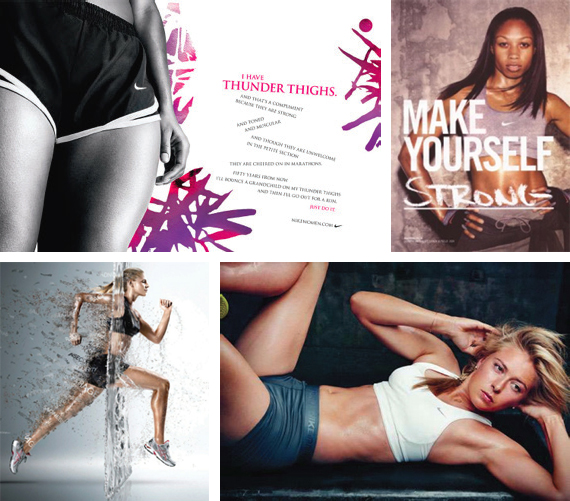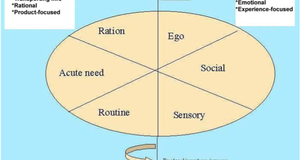From Elon Journal of Undergraduate Research in Communications VOL. 6 NO. 2Psychological Effects of Fitness Advertising on Female Collegiate Athletes
IN THIS ARTICLE
KEYWORDS
AbstractIn recent decades, research has focused on the powerful effects of advertising on negative body image. While researchers have studied how the general female population reacts to various advertising techniques, little research has been published on how female collegiate athletes are affected by fitness advertisements. This study examined how these athletes respond to fitness advertisements and which tactics generate positive responses. Based on a focus group conducted with female Division I athletes, the study found that resonating fitness advertisements must be realistic and tell a relatable story using action images, regardless of the model's identity. I. IntroductionMedia and advertising in the 21st century are unavoidable to consumers. Many research studies have examined the profound effects of advertising and its influence on shifting attitudes, evoking emotions, and modifying lifestyle choices. Not only does advertising play a significant role in the consumption of goods and services, it also has the ability to activate social identities by providing cues to consumers about who they are and what they should be (Horne, 2006). Numerous studies have also researched the harmful effects of female advertising on body image and self-esteem. Advertisements that use extremely slim and sexualized models have fueled the female pursuit of "ultra-thinness," which is defined by slender hips and a narrow frame (Horne, 2006). Many advertisements have been heavily criticized for objectifying females and promoting sexualized images of models. The skewed idea of the perfect body that is celebrated in many advertisements today has contributed to lowered selfconcepts, body shaming, and disordered eating in women of all ages (Bisell & Birchall, 2007). More specifically, some fitness companies have recently tailored their advertisement campaigns toward female demographics. ¬Since the implementation of Title IX in 1972, the number of female athletes has increased significantly over time and now creates the majority of frequent participants in fitness activities in the United States (Heinecken, 2013). It is also estimated that one in every three women is involved in an organized sport (Grau, Roselli, & Taylor, 2007). Fitness companies are trying to reach this significant target audience through commercials, social media, and magazine print advertisements. Nike, an advertising powerhouse, and other athletic brands use several advertisement strategies, such as hiring celebrity athlete endorsers and spreading messages that celebrate the physical body. Many studies have focused on how sport advertising shapes identity and attitude in women. However, the extent to which female athletes respond to advertisements has not been researched heavily. Study of this demographic group's extremely active lifestyles and participation in competitive sports may yield new perspective on athletic advertising. This research aimed to explore how female collegiate athletes respond to athletic advertising targeted toward women, and whether these advertisements have a notable psychological impact on female collegiate athletes. This research also sought to investigate the types of athletic advertisements that evoke the most positive reactions from female collegiate athletes. II. Literature ReviewMedia Representation of Female AthletesAdvertising has taken a leading role in consumerist culture, and athletic brands have taken full advantage of its powerful effects. Brands have transformed from being businesses that merely sell goods and services into unique identities with reputations and personalities. Advertising is the platform in which those unique brand personalities are shown to audiences (Horne, 2006). One of the most prominent ways athletic brands promote their identities is through the use of celebrity athlete endorsers. Athlete endorsers are paid by brands to appear in advertisements or promote goods and services. Celebrity endorsements have become a primary way to promote brands and professional sports. The "Jordan Effect" is a prime example of how effective celebrity endorsers can be when it comes to purchasing power. Michael Jordan, an NBA legend, was sponsored by several athletic brands and appeared in many advertisements during his career. In 2003, it was estimated that his impact on the global economy was $13 billion. Horne (2006) also studied professional soccer player David Beckham as a "living ad." The Beckham family is seen as the ultimate goal for families to achieve, demonstrating a vision to the perfect life that everyone wants to strive for. Advertisers have made the public believe that in order to obtain a life like the Beckhams', they must purchase the products that the family endorses. Although celebrity endorsements are common in the sport industry, recent research has revealed the lack of female athlete endorsers in advertising today. One content analysis examined 169 advertisements in six different types of magazines that contained athlete endorsers. The researchers found that despite women's participation in sports, only 12% of advertisements featured female athlete endorsers. Advertisements that included female athlete endorsers were only printed in traditional women's magazines and nonexistent in men's and teens' magazines. According to the research, "This may pose a potential problem with specific audiences, such as teens and fitness buffs, both of whom are not exposed to many female athlete endorsers in magazines" (Grau, Roselli, & Taylor, 2012). Another advertising strategy used by athletic brands is the use of the heroic narrative. Peetz (2002) looked at how sport media uses heroes to portray athletic victories and performance. The study defined the historical meaning of myths and provides examples of how sport advertising, specifically Nike, uses athletic heroes to convey messages to audiences. The findings showed that Nike uses masculine strategies to define the meaning of a hero. These strategies have the potential to skew females' perception of how an athletic "hero" should look and behave (Peetz, 2002). Effects of Fitness Advertisements on Female Self-ConceptThere is an overwhelming amount of research on the psychological effects advertisements have on females. When targeting women, fitness advertisers focus on exercising for vanity purposes rather than competitive sport. According to Horne (2006), appearance and physique are more important to the average woman than having a healthy body. Exercise is marketed "not for physiological fitness or psychological health, but in pursuit of physical perfection" (p. 174). Figure 1. Advertisement #1, Celebrating the Body Figure 2. Advertisement #2, Female Athlete Endorser Figure 3. Advertisement #3, Showing Mental Benefi ts of Exercise Figure 4. Advertisement #4, Sexualizing the Body While it is now more normal for women to be portrayed as strong and successful athletes, females are still commonly presented as a sexual object, which is shown as the reason for their achievements (Smith, 2011). One content analysis found that 81% of women portrayed in advertisements were partially unclothed or sexualized (Grau, Roselli, & Taylor, 2012). Bissel's study (2004) on collegiate athletes' social comparisons to elite athletes revealed that sexualized images negatively influenced collegiate athletes' satisfaction with their body. Decades of research has focused on the powerful effects of advertising on negative body image. While many researchers have studied how the general female population reacts to various advertising techniques, little research has been published on how female collegiate athletes are affected by fitness advertisements. It is necessary to study females participating in college athletics because many fitness brands target this specific audience in their campaigns. This study aimed to answer the following research questions:
III. MethodIn order to investigate the psychological effects of fitness advertising on college female athletes, a focus group was conducted. This qualitative method was beneficial in generating diverse opinions, yet delving deeper into the motivations and beliefs of these women than a survey. The benefit of focus groups "comes from the interaction among the group members as they elaborate on, question, or challenge each other's statements" (Rosenberry & Vicker, 2009, p. 58). While focus groups do not elicit as in-depth responses received through interviews, they do allow for more variety in responses that may give extensive perspectives. A convenience sample of 11 female student-athletes was recruited from current Elon University students. The participants, ranging from 18-21 years of age, all had competed on Division I track and/or cross country teams. A moderator guide was created in order to elicit the responses needed to answer the research questions (See Appendix A). Before the focus group began, each participant stated her age, team sport, and what types of media she consumed most frequently. These background questions gave the author personal information that may influence particpants' perception of advertisement images. The participants then talked about their favorite workout brand and why they chose to buy its products, which may reveal whether advertising contributes as a conscious motivator in purchasing decisions. The conversation then shifted toward participants' opinions of fitness advertising in general. Eventually the athletes were specifically asked about what kinds of models they saw in advertisements and whether advertisements had a positive or negative effect on collegiate athletes. Next, focus group members were asked about their perceptions of advertising images created by fitness brands. The athletes were shown four different print advertisements from three different brands: Nike, Under Armour, and Asics. All three companies were featured on "The Forbes Fab 40: The World's Most Valuable Sports Brands (Ozanian, 2014). The four advertisements were selected based on four categories of advertising techniques that fitness brands frequently used to target women: female athlete endorser, celebration of the body, sexualizing the body, and mental benefits of exercise. The group also watched a video commercial in order to study the psychological effects of video and compare effects of print and video advertising strategies. The commercial was created by Under Armour and featured celebrity supermodel Gisele Bundchen (Jardine, 2014). After each advertisement was shown, the participants wrote down their first impressions, what they liked and disliked about each advertisement, and how they felt about their own bodies after viewing each advertisement. Then the group went around the room and discussed each advertisement. The following are the print advertisements shown to the focus group participants: To discover what advertisement tactics generate positive responses among this demographic, participants' feedback on each print advertisement was coded into positive, negative, or neutral responses. Responses were also categorized based on what the participants noticed in each advertisement. The themes that emerged included body, athletic ability, and product. The fi ndings were used to determine which advertisement received the most "positive" responses and which advertising elements are most noticeable to athletes. This coding also would identify the most successful tactics to target this audience. IV. FindingsResponses to Male-Dominated Fitness AdvertisementsWhen asked about general thoughts on fi tness advertising as a whole, participants offered responses that refl ected a lack of inclusivity for female collegiate athletes. Many participants immediately thought of advertisements picturing muscular men performing some sort of intense exercise. For example, one participant mentioned that when she thought of advertisements done by Gatorade, she imagined sweaty, male athletes participating in sports. Consequently, she didn't drink Gatorade even though she's also an athlete. "I hardly ever drink Gatorade in its true form . . . . I don't know if that's because when they show guys chugging a huge bottle of Gatorade, it's a guy. I would never have a full liter of Gatorade . . . . If I saw a girl drinking it, maybe I would be more inclined to do it." Another participant mentioned that she didn't focus on advertisements that feature men. She assumed those advertisements were not directed toward her so she ignored them. "When I see a commercial and there are guys working out, I just don't focus on that anymore." Responses to Sport Advertising Targeted Toward WomenAccording to the participants, a recent trend for college-aged women is to wear cute, comfortable fitness apparel for more than just exercising purposes. When asked about the fitness advertisements they'd seen featuring women, there was a consensus that fitness brands target the "average" woman and tailor their advertisements to an audience that is "less athletic." Advertisements that target the average woman did not evoke as many positive responses as advertisements that featured women exercising. The participants focused more on functionality than physical appearance when purchasing athletic apparel and viewing fitness advertisements. "I just know that when I work out, I don't want to worry about my looks. I want to feel good in what I wear, but I don't want to worry about, like being beautiful as much as getting the job done." Regarding why companies struggle to connect with female athletes through advertising, one participant pointed out that companies don't know how to segment women into separate audiences. Brands can either market to the woman who works out for vanity reasons or the "hard core" athlete, but it is nearly impossible to simultaneously connect with both audiences. "They market more to men because with females I feel like they don't know what to do . . . . You can market to the person who goes to the gym but doesn't really work out, or you can market to the hard core athlete." Authenticity in Fitness AdvertisingModels in fitness advertisements affected participants' responses depending on not only who they are, but also how they are portrayed. Advertisements that pictured non-athletic celebrities received mostly negative feedback from the group. Participants were less inclined to believe the advertising message if a celebrity was pictured. One participant brought up how she saw a Nike advertisement that featured actress Lea Michele exercising. She didn't understand why Nike would sponsor Lea Michele because she's not known for her athletic abilities, and just thought "she looked stupid." When asked for opinions on seeing high fashion models, such as Karlie Kloss and Gisele Budchen, in advertisements done by Under Armour and Nike, most participants agreed it was "intimidating." "It's pretty intimidating to see a model in those clothes because what are you telling people, to become a model to look like Gisele? Because that's unrealistic because they have no clue what's going into her diet, which is probably very little." "I think it sets unrealistic goals and making people focus too much on looking good when working out." When the group actually saw an Under Armour commercial featuring Budenchen, the participant's perceptions changed. The video commercial featured Gisele intensely punching a boxing bag by herself, while real, negative comments about her were pictured on the walls of the gym she was in. The intent of the video was to show that Budenchen was "fighting" off the negative comments by becoming stronger, regardless of what the public said about her. Many participants felt like the commercial was fierce, inspiring, and relatable. "Girls are tough too. Very realistic as far as working out goes (hair up, sweaty). She doesn't care what people say, positive or negative. She's going to do what she wants to be fit and look good." "Powerful ad. Definitely changed my view of her." "I find this really inspiring because she is fighting off all the mean comments. It is sending the message for the audience to do what they want and that staying strong and being fit is more important." For female athletes, the model portrayed wasn't as important as the action and the authenticity of the advertisement. Who a model is, of course, has an impact on the participants, but whether a model is realistically portrayed while she participates in physical activity proved to be more significant in eliciting positive responses. Regarding what types of advertisements were motivating, respondents preferred seeing professional athletes in advertisements than professional models. One participant said, "I follow most good runners on social media who are sponsored by New Balance, Nike, Under Armour . . . . Seeing people who are actually good at their sport works much better for me." Another student athlete brought up an Under Armour commercial featuring Misty Copeland, a professional ballerina. Even though this participant did not dance ballet, she still believed the advertisement was effective because she identified the ballerina as being like her, an athlete. "I was really inspired by that. I never thought of dancing as that hard core, but if you look at her body, she's so fit and that is inspiring to see how hard she works at her sport and to get to that level. I think it was cool that they played on the whole ‘female athlete' thing." The use of professional female athletes in advertisements, however, was not the only component to what focus group members considered to be an effective advertisement. Female athletes needed to see the athlete or model portrayed in a realistic athletic setting. Participants said they could tell if a model was posing or "faking" exercises, which made the advertisement less appealing. For example, Advertisement #2 pictured American track and field sprint athlete Allyson Felix, who has won several Olympic medals and championships in the 200-meter dash. The focus group participants not only recognized her, but also viewed her as a role model because they participated in the same sport as Felix. However, the advertisement itself received mixed reviews. Some participants appreciated that a female Olympian was shown in a fitness advertisement, saying the advertisement was "inspiring because of the model" and that "it's nice to see an actual talented runner." In contrast, other participants believed she looked "posed" and "too done up." "I didn't appreciate how she (Allyson Felix) was used because she was just there . . . . She just stood out because [sic] who she is, not what she was doing." "It looks silly when her hair is perfectly down." Regardless of Felix's success as an athlete, the advertisement still looked unrealistic to participants because Felix was posed as a model instead of an athlete. Even when a successful athlete like Felix is posing like a model, the advertisement still looked unrealistic to female athletes. This specific audience wanted to see professional athletes in action so they could become motivated by their abilities rather than their physical appearance.Continued on Next Page » Suggested Reading from Inquiries Journal
Inquiries Journal provides undergraduate and graduate students around the world a platform for the wide dissemination of academic work over a range of core disciplines. Representing the work of students from hundreds of institutions around the globe, Inquiries Journal's large database of academic articles is completely free. Learn more | Blog | Submit Latest in Psychology |
























